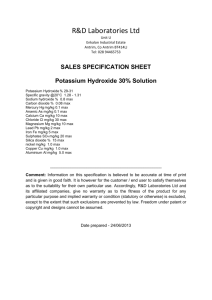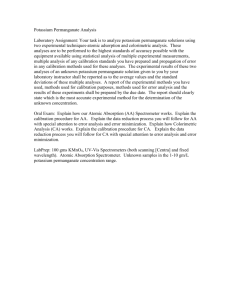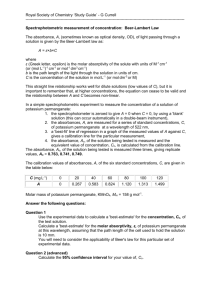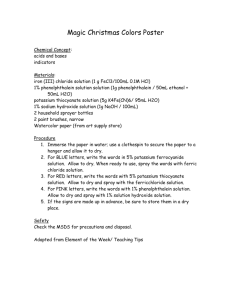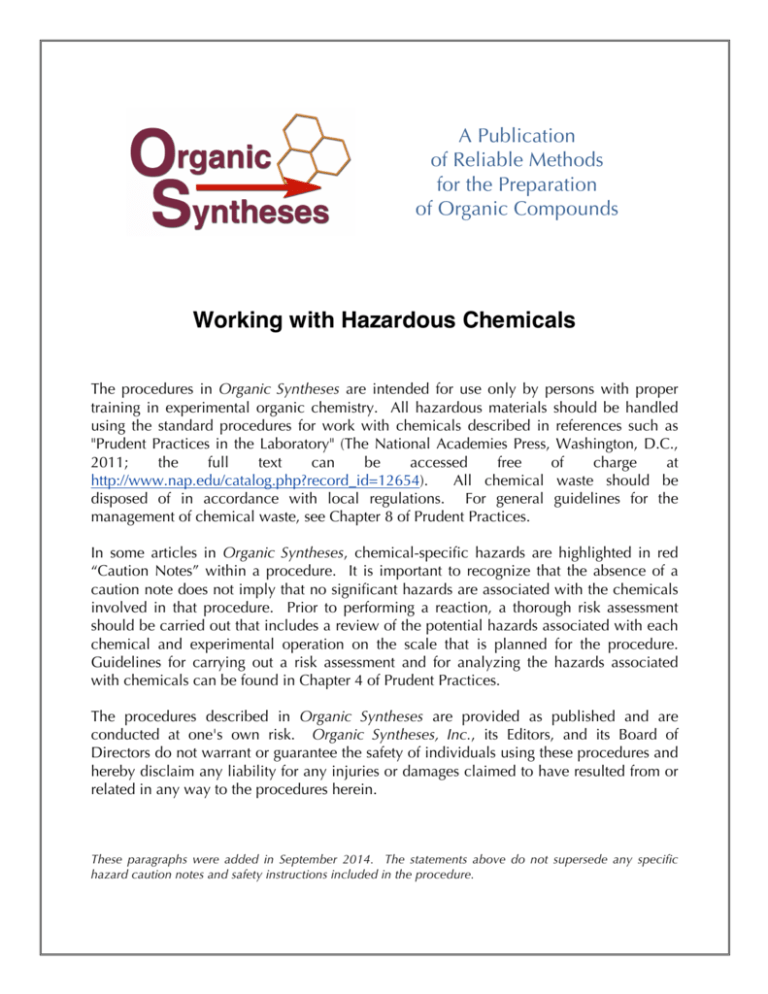
A Publication
of Reliable Methods
for the Preparation
of Organic Compounds
Working with Hazardous Chemicals
The procedures in Organic Syntheses are intended for use only by persons with proper
training in experimental organic chemistry. All hazardous materials should be handled
using the standard procedures for work with chemicals described in references such as
"Prudent Practices in the Laboratory" (The National Academies Press, Washington, D.C.,
2011;
the
full
text
can
be
accessed
free
of
charge
at
http://www.nap.edu/catalog.php?record_id=12654).
All chemical waste should be
disposed of in accordance with local regulations. For general guidelines for the
management of chemical waste, see Chapter 8 of Prudent Practices.
In some articles in Organic Syntheses, chemical-specific hazards are highlighted in red
“Caution Notes” within a procedure. It is important to recognize that the absence of a
caution note does not imply that no significant hazards are associated with the chemicals
involved in that procedure. Prior to performing a reaction, a thorough risk assessment
should be carried out that includes a review of the potential hazards associated with each
chemical and experimental operation on the scale that is planned for the procedure.
Guidelines for carrying out a risk assessment and for analyzing the hazards associated
with chemicals can be found in Chapter 4 of Prudent Practices.
The procedures described in Organic Syntheses are provided as published and are
conducted at one's own risk. Organic Syntheses, Inc., its Editors, and its Board of
Directors do not warrant or guarantee the safety of individuals using these procedures and
hereby disclaim any liability for any injuries or damages claimed to have resulted from or
related in any way to the procedures herein.
These paragraphs were added in September 2014. The statements above do not supersede any specific
hazard caution notes and safety instructions included in the procedure.
DOI:10.15227/orgsyn.041.0024
Organic Syntheses, Coll. Vol. 5, p.445 (1973); Vol. 41, p.24 (1961).
2,7-DIMETHYL-2,7-DINITROÖCTANE
[Octane, 2,7-dimethyl-2,7-dinitro-]
Submitted by W. H. Sharkey and C. M. Langkammerer1.
Checked by Masaaki Takahashi, Marjorie C. Caserio, and John D. Roberts.
1. Procedure
A. 4-Methyl-4-nitrovaleric acid. In a 2-l. three-necked flask equipped with a stirrer and reflux
condenser is placed a solution prepared from 118 g. (1.78 moles) of 85% potassium hydroxide pellets
and 500 ml. of water. A thermometer may be so placed in the third neck that the bulb extends below the
surface of the solution. To this solution is added 300 g. (1.71 moles) of methyl 4-methyl-4nitrovalerate.2 The mixture is stirred and gently heated (Note 1) and (Note 2). After hydrolysis has
started, as indicated by changes in appearance of the hazy reaction mixture, the external source of heat
is removed. The reaction is complete when the cloudy mixture has changed to a clear solution. This
requires about 20–25 minutes (Note 3).
The reaction mixture is cooled to room temperature, and a saturated solution of potassium
permanganate is added in an amount sufficient for a violet color to persist for about 1 minute before
turning green (Note 4). About 100–110 ml. is required. Manganese dioxide is removed by filtration, and
the filtrate is extracted with methylene chloride to remove non-acidic organic material. The aqueous
layer is acidified with 18% hydrochloric acid, whereupon a pale yellow or green oil separates as a
bottom layer. The oil is removed, and the aqueous layer is washed with methylene chloride. The
washings are added to the oil, and the combined product is dried with anhydrous magnesium sulfate.
Methylene chloride is removed by distillation, and the residual oil is distilled under reduced pressure
through a 6-in. Vigreux column (Note 5). The fraction boiling at 125–135° (0.9–1.5 mm.) amounts to
217–225 g. (79–82%) and is a colorless oil that crystallizes on standing or when seeded to give a solid
with a melting point of approximately 35–45°. This fraction is redistilled through a 24-in. spinning-band
column and gives 166–180 g. (60–65%) of colorless 4-methyl-4-nitrovaleric acid, b.p. 122–124°/0.70–
0.90 mm., m.p. 45–46° (Note 6).
B. 2,7-Dimethyl-2,7-dinitroöctane. A 200-mm. desiccator is adapted for use as an electrolysis cell.
A lid is prepared from a glass plate ground to fit the desiccator; holes are bored in the lid to
accommodate electrodes, a thermometer, and a stirrer, and to provide an opening for making additions
to the cathode compartment. The cathode (Note 7) is placed in a porous ceramic cup having outside
dimensions 4 in. deep, 6 in. long, and 2 in. wide (Note 8). This cup is placed on the glazed ceramic plate
of the desiccator under the holes cut in the lid for the cathode and for making additions. The glazed
ceramic plate is notched so that it can be slipped down over the supports in the bottom of the desiccator.
The notches should be large enough for the ceramic plate to be about halfway between its normal
position and the bottom of the desiccator (Note 9). The cathode is a 26-gauge stainless-steel plate 3 in.
square (Note 10), and the anode consists of two platinum plates each 0.01 in. thick and 3 in. square
(Note 11) placed as close as possible, one on either side, to the ceramic cup without touching the sides
of the cup.
A solution made by dissolving 161 g. (1 mole) of 4-methyl-4-nitrovaleric acid and 33.0 g. (0.5
mole) of potassium hydroxide in 2.7 l. of methanol is added to the cell. The ceramic cup is filled with
200 ml. of 2N potassium hydroxide in methanol. The cell contents are cooled to 20° (Note 12), and
current is passed through the solution (Note 13). When the current is turned on, vigorous evolution of
hydrogen takes place inside the porous cup. Potassium hydroxide (2N) in methanol is added as needed
to maintain the original volume inside the cup (Note 14). Carbon dioxide is evolved at the anodes. After
about 5 hours, white crystals of the dinitroöctane form in the anode solution. As electrolysis proceeds,
the resistance of the cell increases, and after several hours the cell is operated at 3–5 amperes and 60–80
volts. If a current of 3–5 amperes cannot be maintained, it is desirable to add 2N potassium hydroxide in
methanol to the anode compartment (Note 15) and (Note 16). After 8 hours of operation, the current is
shut off, the ceramic cup removed and cleaned, and the anode solution cooled to about −30°. The anode
solution is filtered to remove crystals of 2,7-dimethyl-2,7-dinitroöctane. The yield of dry product, m.p.
98–100°, amounts to 50–65.5 g. (43–56%), which is sufficiently pure for most uses (Note 17). One
recrystallization from methanol (Note 18) gives pure 2,7-dimethyl-2,7-dinitroöctane, m.p. 100–101°
(lit.3 101.5–102°).
2. Notes
1. If stirring is not used, hydrolysis does not start until the reaction mixture is heated almost to the reflux
temperature. Under these conditions the reaction, which is exothermic, proceeds so rapidly that the
reflux condenser is flooded.
2. Although no explosions have yet occurred, it is advisable to conduct this reaction behind a shield.
The hydrolysis, once started, proceeds quite rapidly.
3. The time required varies with the initial temperature of the hydrolysis solution. With warm solutions,
e.g., freshly made potassium hydroxide solution, external heating is not needed. With such a solution,
the checkers found that a cloudy mixture having an initial internal temperature of 40° became clear
within 2–5 minutes of mixing and during this time the temperature rose to 70°. Stirring was continued
for 20 minutes to ensure complete hydrolysis.
4. Addition of potassium permanganate removes colored impurities that otherwise persist through
subsequent distillations of the acid. The maximum concentration of potassium permanganate in water at
room temperature is about 5%. It may be more convenient to use a concentrated solution of sodium
permanganate, which is very soluble in water. However, the end point is difficult to observe with
sodium permanganate.
5. During this first distillation, nitrogen oxides are evolved in appreciable amounts. It is suggested this
operation be done behind a shield in a well-ventilated area. A trap cooled with a mixture of solid carbon
dioxide and acetone or with liquid air should be inserted between the column and the vacuum pump.
Pumps used in this distillation did not appear to suffer corrosion damage. A dry oil was used and
changed after each distillation.
6. It may be necessary in this second distillation to apply a source of heat to the fraction-collecting
system to prevent crystallization of the product prior to entry of the distillate into the receivers.
7. The cathode is the electrode connected to the negative terminal of the current source.
8. A satisfactory alumina cup may be purchased from the Norton Company, Worcester, Mass., Catalog
No. 44805, RA-98.
9. This is necessary because the top of the porous cup must be below the lip of the desiccator. The
volume of the desiccator up to the top of the porous cup should be 4 l.
10. The considerable heat generated inside the cup leads to rapid evaporation of the methanol with
which the cup is filled. The cell can be operated by constant replenishment of methanol. However, loss
of methanol can be minimized by use of a water-cooled cathode. Such an electrode is conveniently
prepared from two 3-in.-square stainless-steel plates and a strip of stainless steel about 0.25 in. wide,
which are welded to form a stainless-steel box. Nipples serving as water inlet and outlet are welded to
the top of the box.
11. The 3-in.-square platinum plates are welded to a heavy platinum wire that protrudes through one of
the holes cut in the glass lid. Heavy copper wire (No. 10) is used to connect the electrodes to the source
of current.
12. This temperature is easily maintained by surrounding the cell with a methanol bath cooled with solid
carbon dioxide. About 100 lb. of solid carbon dioxide is required for 8 hours' operation. Yields are
severely reduced if the methanol is allowed to boil. Temperatures lower than 20° can be used but are
less satisfactory.
13. The initial current is usually 6–8 amperes at 50–60 volts. The resistance of the cell constantly
changes because of depletion of electrolyte and deposition of potassium methoxide in the pores of the
ceramic cup. The preferred source of current is a rectifier capable of delivering 10–15 amperes at 30–90
volts. Lead storage batteries connected in series are also satisfactory but require frequent recharging.
14. In a typical run, 30 ml. of 2N potassium hydroxide in methanol was added at the end of each hour of
operation. Total addition was 210 ml.
15. The amount added must be less than that required to bring the pH to 7. When the pH of the anode
solution is greater than 7, undesirable reactions occur.
16. The checkers found that after 5.5 hours the current dropped below 3 amperes at 75 volts. Addition of
25 ml. of 2N potassium hydroxide in methanol to the anode solution increased the current to 6 amperes.
Subsequent additions of 10–15 ml. of base were made approximately every 30 minutes. The total
volume of base added was 80 ml.
17. Some unchanged 4-methyl-4-nitrovaleric acid can be recovered from the spent electrolysis solution
by alkaline extraction followed by acidification and distillation of the water-insoluble oil. However,
under ordinary circumstances, recovery of this material is not worth the effort expended.
18. About 500 ml. of refluxing methanol and 58 g. of crude product afford about 53 g. (95% recovery)
of recrystallized material.
3. Discussion
2,7-Dimethyl-2,7-dinitroöctane has been prepared by nitration of 2,7-dimethyloctane.3
4. Merits of Preparation
Kolbe electrolysis is generally useful for the formation of hydrocarbons from monocarboxylic acids
and for the preparation of many difunctional compounds as well. A specific illustration is the synthesis
of esters of long-chain dicarboxylic acids from monoesters of appropriate dicarboxylic acids (see p.
463). A number of these syntheses are discussed by Fichter.4 In the present preparation, a twocompartment cell is employed to avoid, or at least greatly reduce, undesired reduction of the nitro group
at the cathode. It seems likely that the procedure could be adapted to the preparation of other
difunctional compounds containing groups that are easily reduced.
References and Notes
1. Contribution No. 516 from the Central Research Department, Experimental station, E. I. du Pont
de Nemours and Co., Wilmington, Del.
2. R. B. Moffett, Org. Syntheses, Coll. Vol. 4, 652 (1963).
3. M. Konowalow, J. Russ. Phys-Chem. Soc., 38, 124 (1906) [Chem. Zentr., 1906, II, 314].
4. F. Fichter, Organische Elektrochemie, p. 17, Theodor Steinkopff, Dresden and Leipzig, 1942.
Appendix
Chemical Abstracts Nomenclature (Collective Index Number);
(Registry Number)
hydrochloric acid (7647-01-0)
methanol (67-56-1)
hydrogen (1333-74-0)
potassium permanganate (7722-64-7)
carbon dioxide (124-38-9)
acetone (67-64-1)
potassium hydroxide (1310-58-3)
manganese dioxide (1313-13-9)
methylene chloride (75-09-2)
magnesium sulfate (7487-88-9)
potassium methoxide (865-33-8)
2,7-dimethyloctane (1072-16-8)
Octane, 2,7-dimethyl-2,7-dinitro-,
2,7-Dimethyl-2,7-dinitrooctane (53684-51-8)
4-Methyl-4-nitrovaleric acid (32827-16-0)
sodium permanganate (10101-50-5)
methyl 4-methyl-4-nitrovalerate (16507-02-1)
Copyright © 1921-2005, Organic Syntheses, Inc. All Rights Reserved



